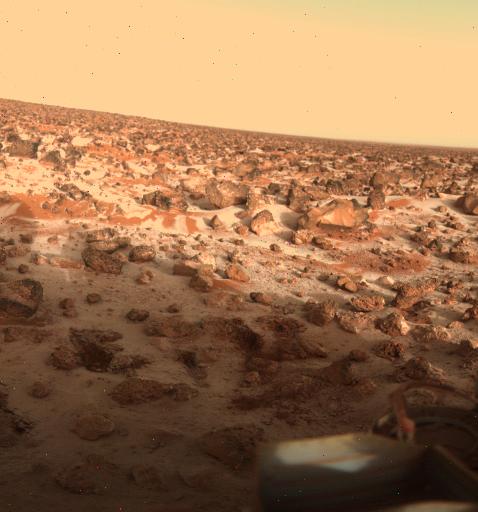Thus far in my on-again/off-again mission to Mars, I’ve learned that while ancient Mars may have been a wet and watery place, that does not necessarily mean it was anything like Earth. The evidence I’ve seen from Mars’s Tharsis region and the surrounding area suggests that Mars has had a rather violent history with water. But I’ve heard that other regions—most notably the Utopia Planitia region—may have a different story to tell about Mars’s watery past… and its watery present.
I’ve only just started learning about Utopia Planitia, and right away I was in for a surprise. On September 13, 1977, the Viking-2 Lander took a photograph of what appeared to be a light dusting of snow on the ground. Then on May 18, 1979, approximately one Martian year later, it happened again. This is the 1979 photo:

We can’t be 100% sure what happened, specifically. Did it really snow at the Viking-2 landing site, or does it just look like snow? Could it instead be a layer of frost, like how back on Earth morning dew turns to frost during the winter? Is this snow/frost made of frozen H2O, frozen CO2, or a mixture of both?
Personally I’d like to believe that it snowed, and that it was genuine H2O snow. I love snow. I love how quiet and pretty and restful snow is, and somehow the idea of snow drifting even more slowly to the ground (because of Mars’s reduced gravity) appeals to me. I wish I’d started studying something other than the Tharsis Bulge and Valles Marineris canyon earlier, because clearly I’ve been missing out!
P.S.: I think there should be something like the Lunar X-Prize for whoever builds the first snowman on Mars.
would that make it a snowmartian?
LikeLiked by 3 people
Maybe!
LikeLike
How about a rover that picks up the rocks and builds its own hut. Though that may be self-defeating as it would lose line of sight with the Sun.
LikeLiked by 1 person
That would be impressive. I remember the previous NASA director saying he wanted rovers that could build underground habitats for us before human astronauts even arrived. But the thing about losing sunlight, and also losing radio contact with Earth, seemed like it would be a problem.
LikeLiked by 1 person
How do we know for sure what Mars was like or is like now? Seems like we would need to dig deep below the surface to examine all the layers to see the geological and meteorologic history.
LikeLiked by 1 person
That’s true. We do. And there are a few upcoming missions that are supposed to do just that, either by digging or through seismology.
LikeLiked by 1 person
That would be very interesting, to get under the surface.
LikeLiked by 1 person
I’m definitely looking forward to it!
LikeLiked by 1 person
Wow. I hadn’t seen this before. I like to think it’s snow, but even if it’s frost, like you say, and it’s still pretty great.
LikeLiked by 1 person
Yeah, this was a huge surprise to me when I read about it. You’d think this kind of thing would be common knowledge for space enthusiasts like us. I’m really surprised this doesn’t get more press.
LikeLike